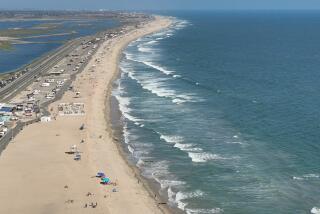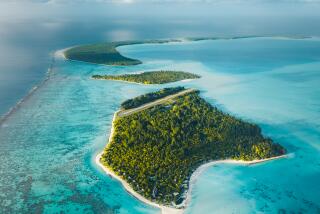Remotely Possible
- Share via
VELASSARU ISLAND, Maldives — For an island aficionado like myself, the Maldives are everything to ask for: luscious turquoise waters caressing fine white coral sands, breezes lazily rustling coconut palms, unparalleled diving and snorkeling, and prices typically one-half or less those of similar resorts in the Caribbean or the South Pacific.
The trick is getting there. You have to travel halfway around the world, 12,000 miles and two days’ flying time from the West Coast to the Indian Ocean. Consequently, air fares aren’t cheap.
But early last year, I overcame these obstacles through a happy coincidence of some free time and an abundance of frequent-flier miles. I was finally going to visit the Maldives, islands that took my breath away after seeing them in a calendar photograph more than a decade ago.
Another difficulty arose in booking one of the Maldives’ 74 fully contained resort islands. Travel agents I talked to were of little help; mentioning the Maldives produced blank stares. And communicating with the remote country, a cluster of 1,190 tiny coral islands southwest of the Indian subcontinent, was difficult. Most of my faxes to various resorts I’d researched went unanswered. I did get one response, though, from Laguna Beach Resort on Velassaru Island, so that’s where I ended up spending eight nights last March.
All that time and effort would have been wasted had I arrived to disappointment. But my doubts dissolved when I glimpsed the turquoise dots that appeared outside my jet window on the last leg of the journey from Colombo, Sri Lanka. Arriving at Male’s international airport (essentially a runway connecting two islands) after almost two days of traveling, I breezed through immigration and customs. I was met by a helpful resort representative who escorted me and a young French couple to a diesel-powered dhoni, the ubiquitous island boats, for our 40-minute ride to Laguna Beach Resort.
At the resort’s dock, my bags were whisked away and a waiter offered a soothing glass of cold papaya and orange juice. All around me was powdery white sand, towering coconut palms, a cloudless blue sky--the calendar photograph come alive!
A walk around the island to get my bearings took no more than 30 minutes. Nestled among palm trees, plumeria, hibiscus and bougainvillea are a little over 100 rooms (arranged in two-story, four-unit clusters), five restaurants, a bar (alcohol, while officially banned in this Islamic republic, is served on resort islands by non-Maldivian employees), a pool, two tennis courts and a gym. The modern rooms, which have tile floors, rattan furniture and fabrics reminiscent of Balinese designs, are set back from the beach and arranged so that each one faces the lagoon. Like most resorts in the Maldives, this one is fully contained: In addition to guest facilities, the island has staff housing, a desalinization plant, and a small mosque for the Muslim employees.
My room was air-conditioned and had all the amenities, including a hair dryer, a mini-bar and a palm-shaded veranda. The room rate was higher than I’d hoped to pay--$140 per night, including breakfast--because of last-minute planning. But that price compared favorably to similar luxury properties in other tropical paradises; a garden bungalow in a comparable resort in, say, Bora-Bora, would cost at least $300 a night.
But it was on my first evening, during a walk on the beach, that I remembered why I came here. Instead of glittery native dance revues or staged dolphin shows, the entertainment was uncountable twinkling stars, velvety warm winds, the smell of plumeria blossoms, and soft sand, still warm from that day’s sun, on my bare feet.
*
Perched on the equator, the Maldives is little known to most Americans as a vacation destination. At Laguna Beach, I was the lone Yankee among mostly European guests. But I didn’t mind. My fellow vacationers weren’t bound by nationality but by a frame of mind not unlike that of Mathieu Rouanet, a Frenchman who told me that he and his wife came here seeking “someplace warm and relaxing, to escape the stress and cold of Paris.”
According to Abdulla Yasir, a cool and professional assistant front desk manager in a crisp white shirt and conservative tie, most Americans who do visit the Maldives are expatriates working in the Middle East and “looking . . . for good value for their money.”
The Maldives have been inhabited for thousands of years, and for a time were under British protection. That ended in 1965, when the islands, grouped within 26 atolls and spread over nearly 35,000 square miles, became an independent republic.
Velassaru Island is located in the southern portion of Kaafu Atoll, which includes Male (pronounced MA-lay) the capital, and about two-thirds of the resorts. The remaining resort islands lie within Ari Atoll, just west of Kaafu. As a result, many resorts are an easy boat ride from the airport. (The congregation of resorts to two main atolls also allows the Maldives government better control over tourism, ostensibly to protect the Muslim culture from Western influences.)
My days usually started before dawn, to photograph the sunrise. Then I typically grabbed a shower to cool down from the uncomfortably hot, humid weather, already in the 80s by midmorning. That was followed by a huge buffet breakfast in the hotel’s main dining room.
Now came decision time: Which glorious beach should I hang out at today? Having lived in Hawaii and traveled to French Polynesia, the Cook Islands and the Caribbean, I can vouch that Maldives beaches are right up there with the best in the world. Velarassu’s lagoon showed off its finest colors at midday, with the sun directly overhead.
In this equatorial sun, tans quickly turn sunburn, so it became my habit to seek shelter under the palms and tropical shrubs that line the beach every 20 minutes or so; I found myself constantly moving from water, to sand, to shade.
Scuba diving off these islands is said to be among the best in the world, with 800 varieties of fish. A Lonely Planet guide to the Maldives comments that “going to the Maldives and not diving is like going to the Himalayas and not trekking or going to Singapore and not shopping.”
“The gorgeous tropical scenery you see before you is only half of the beauty in the Maldives,” Bertrand Leidi, a Laguna Beach dive instructor, told me. “The other half is underwater.” My regrettable lack of certification prevented me from verifying this claim.
But the avid beach bum in me took selfish pleasure in the fact that the more people diving, the fewer people there were on the sands of this 100-acre island. I often had entire beaches to myself.
*
Because of its five restaurants, Laguna Beach offered more dining choices than usually found when you are held captive by the repetitive fare at many island resorts. The Dragon Inn serves Chinese, the Four Seasons is Italian, and flame-broiled seafood is available at the beach-side Palm Grill, all of which looked elegant and enticing, and cost $20-$30 per person for dinner.
Partly to economize--those giant breakfasts kept me satisfied all day--and partly because I was alone, I stuck to the two others. Summerfields, where all full- and half-board guests took their meals, offered good continental-style buffets, and Cafe Laguna provided room service and snacks.
Since coral islands are inhospitable to agriculture, most food in the Maldives has to be imported. But fresh seafood--fishing is a chief industry--and tantalizing Indian and Sri Lankan spices made up for the lack of local ingredients. My favorite meal was Curry Night at Summerfields, where spicy chicken, beef, egg, beet root and potato curries were laid out in flavorful abundance.
Even a beach bum needs a break from crystal-clear lagoons, so one day I took an excursion offered by most Maldivian resorts: a half-day visit to Male. A dozen other guests and I piled into a dhoni for the half-hour ride to the Maldives’ capital, whose low skyline is dominated by the elegant gold dome of Masjid Al Sultan Mohammed Thakurufaanu Al A’z’am Grand Mosque.
*
In contrast to the quiet resort islands, Male bustles. With a population of more than 60,000 living on this 400-acre island, it came as a brutal dose of reality. Drab, functional architecture predominates, and whiny motorcycles and deteriorating cars scurry down narrow roadways. The tourist sector is essentially a couple of blocks, not far from the waterfront, where half a dozen shops sell tacky Indonesian and Philippine souvenirs, and few genuine Maldivian crafts. About the only things that looked worth buying were locally made wooden vases--elegantly lacquered in red, gold and black--and small models of dhonis carved from wood, mother-of-pearl and black coral, nicely crafted but too steeply priced for my budget.
One other day, I joined a group for a helicopter ride over Kaafu Atoll to Rihiveli, a French-run resort about 20 miles south of Velassaru Island. Rihiveli actually consists of three islands, with two minuscule uninhabited islands that lie across a shallow lagoon from the main resort.
To get to one of the little islands, all of us waded across the lagoon, which was so shallow the water never reached above my waist. Once there, we were served a picnic lunch of grilled barracuda, coleslaw, rice and fruit. We spent the rest of the afternoon swimming, snorkeling and basking amid the coconut palms, pristine white sands and clear blue skies of our own private heaven.
Alas, after eight days my stay had regrettably come to an end. As I boarded a dhoni for the ride back to the airport, I became melancholy. It had taken me 10 years to finally reach this far-flung paradise and now I had to go home. But the sadness didn’t last long. The Maldives, as remote as they are, turned out to be everything that calendar picture promised.
(BEGIN TEXT OF INFOBOX / INFOGRAPHIC)
GUIDEBOOK
Maldives Break
Getting there: Flights into the Maldives arrive from Singapore, Frankfurt (Germany), Colombo (Sri Lanka), Karachi (Pakistan) and Dubai (United Arab Emirates). From LAX, the easiest routes are probably via Singapore (on Singapore Airlines), then change planes for a nonstop flight to Male, the Maldives capital; or via nonstop flight to Frankfurt (on LTU), then nonstop to the Maldives. Prices vary according to season and carriers, but expect to pay between $1,500 and $1,900 for the lowest economy fare.
When to go: High season, the driest, coolest time of year (and also when room prices and crowds peak) is between December and March.
Where to stay: There are 74 resort islands in the Maldives from which to choose; expect to pay between $80-$200 a night per double for most resorts that are in between the economy and super-deluxe levels. I chose Laguna Beach Resort, which I booked through Universal Enterprises Ltd. in Male (telephone 011-960-322-971, fax 011-960-322-6780). Several guidebooks on the Maldives list lodgings including Lonely Planet, Passport Books and Globe Pequot’s “Guide to the Maldives” by Royston Ellis. Another source I discovered--U.S. travel agents familiar with islands were difficult to find--is a specialist named Toni de Laroque, who calls herself “The Maldive Lady”; contact her at Maldive Travel, London, tel. 011-44-171-352-2246, fax 011-44-171-351-3382.
For more information: Maldives Assn. Tourism Industry (MATI), tel. 011-960-326-640, fax 011-960-326-641. There is no Maldives tourist information office in the U.S. MATI’s Web site is at https://www.maldives.com.
More to Read
Sign up for The Wild
We’ll help you find the best places to hike, bike and run, as well as the perfect silent spots for meditation and yoga.
You may occasionally receive promotional content from the Los Angeles Times.






